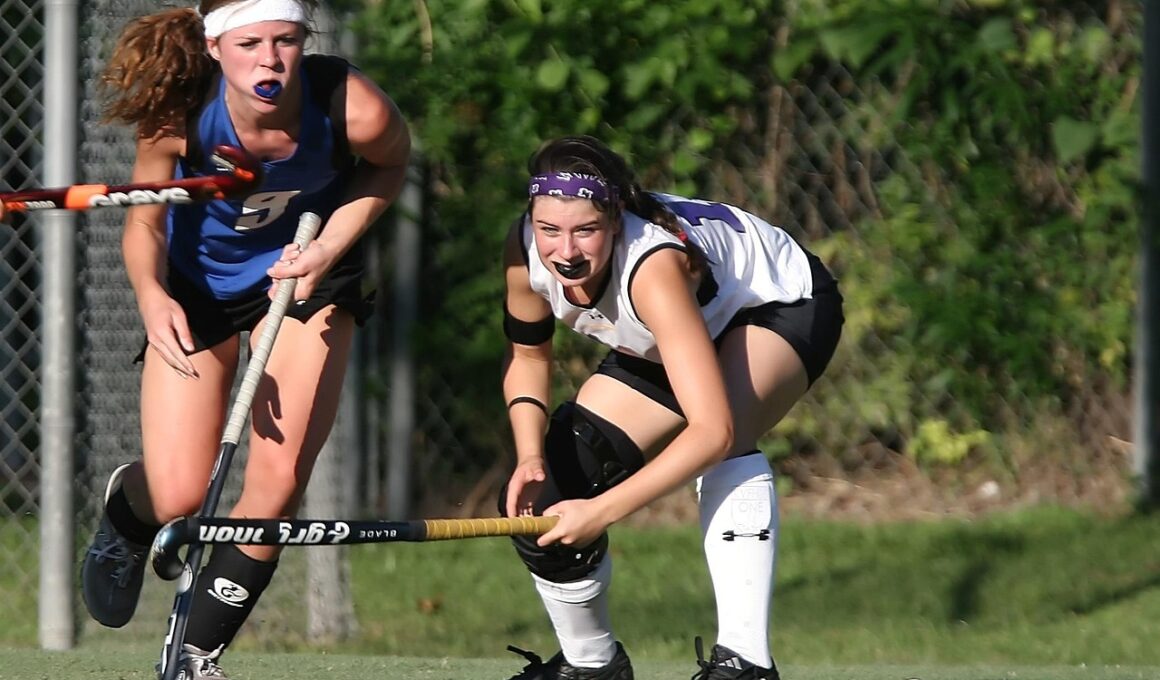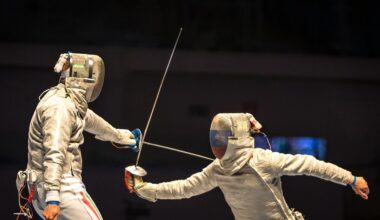Bodyweight Exercises for Field Hockey Circuit Training
Field hockey players require a unique blend of agility, strength, and endurance. Circuit training combines various bodyweight exercises to address these aspects, boosting both physical performance and skill level. A well-designed circuit helps players achieve comprehensive fitness and conditioning tailored to the rigors of field hockey. One critical advantage of bodyweight exercises is the elimination of the need for equipment, allowing for versatile training routines that can be executed anywhere. The circuit should involve dynamic movements that replicate on-field actions, enhancing coordination, balance, and agility. These exercises can include bodyweight squats, push-ups, lunges, and burpees, which collectively will improve cardiovascular fitness. Incorporating variations such as plyometric push-ups and jump squats can promote explosive power crucial for sprinting and shooting abilities on the field. Additionally, tailoring workouts for specific muscle groups keeps the training engaging and assists in preventing injuries while maximizing performance. Establishing a circuit routine not only enhances physical capabilities but also promotes mental resilience among athletes, crucial under competitive settings. Adapting to different exercise intensities keeps the circuit challenging and allows for ongoing progression, supporting long-term fitness goals.
Essential Bodyweight Exercises for Field Hockey Players
The foundation of any effective circuit is the selection of suitable exercises that target the specific needs of field hockey players. Some essential bodyweight exercises to incorporate include push-ups, which build upper body strength, vital for tackling opponents. Squats serve to enhance leg strength, necessary for powerful movements and balance on the field. Lunges are essential as they focus on unilateral strength, while incorporating mobility necessary for advancing the puck effectively. Plank variations strengthen the core, enhancing stability during fast-paced plays and assisting in the prevention of injuries. Burpees are excellent for conditioning, combining cardiovascular and muscular endurance in one demanding movement. Additionally, mountain climbers can improve core stability while simulating the quick footwork needed in games. Jump squats are effective for developing explosiveness, enabling players to execute jumps or sprints with power. To increase difficulty, consider time-based circuits where players perform each exercise for a set duration, providing a high-intensity workout. Following the circuit with proper stretching is essential for recovery, ensuring flexibility and reducing soreness following these rigorous workouts.
Incorporating Training Variations for Complete Development
To achieve maximum benefit from circuit training, incorporating variations into workouts is crucial. This approach not only prevents monotony but also promotes overall development across multiple fitness aspects. For instance, rotating through different variations of lunges, such as reverse or lateral lunges, can challenge different muscle groups, keeping the body engaged and adaptive. For upper body strength, use modified push-up variations, such as incline or decline push-ups, which target distinct muscle areas, enhancing strength further. Additionally, integrating agility ladders or cones into circuit settings promotes foot speed, agility, and coordination necessary for effective field hockey maneuvers. Incorporating high-intensity interval training (HIIT) principles into circuits can elevate cardiovascular conditioning. Combining short bursts of intense exercise with active recovery maintains heart rates while building endurance. Introducing resistance bands can also provide additional challenges, contributing to strength gains without complicated equipment. Change the order of exercises regularly to keep participants focused and motivated, as novelty keeps workouts effective. These considerations ensure a balanced training routine, preparing players for the multifaceted demands of the sport.
Advantages of Circuit Training for Field Hockey Performance
Circuit training offers numerous advantages specifically tailored to field hockey athletes. One key benefit is the enhancement of both aerobic and anaerobic fitness levels, crucial for performing during intense matches. With varying intensity levels, circuit training ensures that players engage their energy systems effectively, mimicking the demands of a game. Moreover, bodyweight exercises reduce the risk of injury by promoting functional strength through full range-of-motion movements that are less likely to cause strain. The dynamic nature of these workouts trains players to exhibit agility and coordination, skills essential in field hockey. Circuit training also promotes mental toughness, as athletes push through fatigue while developing endurance critical for performance. These sessions are easily adaptable to individual athletes or groups, making them accessible for teams at any level. Furthermore, seamless integration of strength and conditioning allows for a structured approach that benefits players throughout their training. The emphasis on specific muscle groups relevant to the sport ensures that training remains efficient. Circuit workouts can also be tailored according to seasonal needs, preparing players for upcoming tactical demands during matches.
Creating an Effective Circuit Training Schedule
Designing a well-structured circuit training schedule can optimize performance benefits for field hockey players. Start by defining clear objectives—whether focusing on strength, speed, endurance, or a combination of these. Develop circuits that include 6 to 8 exercises targeting different muscle groups, promoting holistic physical conditioning. A session may begin with a brief warm-up to prepare muscles and joints, followed by the circuit itself. Ensure that exercises include varying intensity levels to maintain engagement. A fundamental structure can comprise 40 seconds of intense exercise followed by 20 seconds of rest, adapting the timing as needed based on fitness levels. Incorporating varied formats, such as alternating upper and lower body exercises, facilitates maximum efficiency and allows for active recovery while focusing on another muscle group. After approximately 15-30 minutes of circuit work, conclude with a dedicated cooldown phase. This phase should engage stretching for muscles worked during the circuit, promoting recovery while enhancing flexibility. Evaluating performance after training sessions helps assess progress, guiding adjustments for future workouts to align with the players’ changing needs and fitness levels.
Tips for Staying Motivated During Circuit Training
Motivation is essential in maintaining consistency and commitment to circuit training for field hockey players. One effective approach is establishing specific, measurable goals, which can enhance focus and provide a sense of accomplishment as successes accumulate. Incorporating a buddy system fosters accountability, allowing players to encourage one another through challenging workouts. Additionally, tracking progress through fitness apps or journals can emphasize improvement over time, providing motivation to continue. Setting realistic expectations, particularly in the early stages of training, helps athletes understand that development will be gradual, reducing frustration levels. Regularly changing workouts keeps both the exercises and intensity fresh, sustaining engagement and excitement during training sessions. Infusing fun elements, such as friendly competitions or challenges within the circuits, can create an enjoyable atmosphere that promotes camaraderie. Integrating music that energizes players further enhances motivation during workouts, making sessions feel invigorating. Prioritizing adequate recovery time also contributes to motivation, as consistent progress hinges on the body’s ability to bounce back, ensuring players feel strong and ready for the next training phase.
Conclusion: Elevating Field Hockey Performance With Circuit Training
Utilizing circuit training focused on bodyweight exercises has been proven highly effective in enhancing performance for field hockey players. The great flexibility of circuit training allows it to target the specific demands of the sport while improving both fitness and skill. By engaging in diverse bodyweight workouts, athletes improve their strength, agility, and cardiovascular fitness, all of which form essential elements of field hockey performance. The adaptability of these routines can cater to varying skill levels and identify individual goals, creating a personalized training experience. The mental resilience developed through such rigorous workouts primed athletes for the pressures of competition, making them stronger contenders. Coaches and trainers can benefit significantly by incorporating these circuit training techniques into team regimens, ensuring comprehensive player development. Overall, the commitment to establishing a sound circuit training approach fosters a high level of performance on the field. Ultimately, by blending physical conditioning with specific skill-based exercises, players can significantly elevate their game, creating a dynamic impact on their team’s successes.


